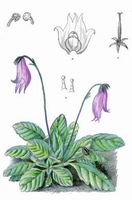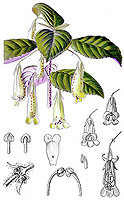
Bot. Mag. t. 8896 (1938)
Full name and orig. publication: Briggsia Craib, Notes Roy. Bot. Gard. Edinburgh 11: 236 (Nov. 1919).
Etymology: Named after Munro Briggs Scott, a young talented botanist, herbarium assistant at Kew, who fell in a battle in 1917.
Synonyms: -
Infrafamilial position: Didymocarpoid Gesneriaceae - "Advanced Asiatic and Malesian genera" (Weber 2004).
Description: Perennial acaulescent or caulescent herbs, stem usually unbranched. Leaves in a basal rosette or spaced along stem or tufted at stem top, opposite (?rarely alternate), those of a pair equal or unequal, petiolate, lamina ovate or elliptical, base cunate, attenuate of cordate, rarely peltate. Cymes axillary, 1- to many-flowered, lax or rarely subumbellate. Sepals free, rarely fused halfway. Corolla broad-tubed, tube 2-3x longer than limb, ventrally pouched, blue, purple, red, orange or white, usually spotted within; limb bilabiate, upper lip 2-lobed, much or slightly shorter than 3-lobed lower lip, lobes (sub)equal, rounded, truncate or acute. Stamens 4, inserted at corolla base, rarely at or above middle, included; anthers basifixed, coherent in pairs at the apices, thecae divergent, apically confluent or not, longitudinally dehiscent; staminode present or lacking. Nectary ring-like. Ovary oblong to linear, with parietal placentae; stigma 2-lobed, lobes equal, undivided. Capsule straight, much longer than calyx, loculicidally dehiscent.
Chromosome number: 2n = 34, 68.
Species number: About 22.
Species names (incl. publication and synonyms): See Skog, L.E. & J.K. Boggan. 2005: World checklist of Gesneriaceae: http://persoon.si.edu/Gesneriaceae/Checklist.
Type species: Briggsia longifolia Craib
Distribution: Bhutan, C & S China (21 spp.; Yunnan, Sichuan, Guangxi, Guizhou, Hunan, Xizang, Hubei, Zhejiang, Jiangxi, Anhui), India, Myanmar, Vietnam.
Ecology: Terrestrial plants, usually growing on damp rocks, within forests or above the forest belt, 300 - 3700m.
Notes: The delimitation of Briggsia and Loxostigma is still somewhat problematic, and some species placed in Briggsia may be perhaps better referred to Loxostigma which itself is somewhat intermediate between Briggsia and Lysionotus (Burtt 1975, Wang & al. 1990: 272).
Selected references: Burtt, Notes Roy. Bot. Gard. Edinburgh 21: 195 (1954), ibid. 34: 101-106 (1975) notes; Pan, Acta Phytotax. Sin. 26(6): 450-457 (1988), new spp.; Wang et al. in Wu & Raven (eds.), Fl. China 18: 272-280 (1998) (Chinese spp.); Hilliard, in Grierson & Long, Fl. Bhutan 2(3): 1306-1308 (2001), reg. rev.
Bibliography: See Skog, L.E.
Bibliography: amp; J.K. Boggan. 2005. Bibliography of the Gesneriaceae. 2nd edition: http://persoon.si.edu/Gesneriaceae/Bibliography.
Illustrations:
 |
Briggsia agnesiae Craib
Bot. Mag. t. 8896 (1938) |
 |
Briggsia kurzii
(C.B.Clarke) W.E.Evans
Bot. Mag. t. 9181 , as Loxostigma amabilis |
last modified: 2007-06-13